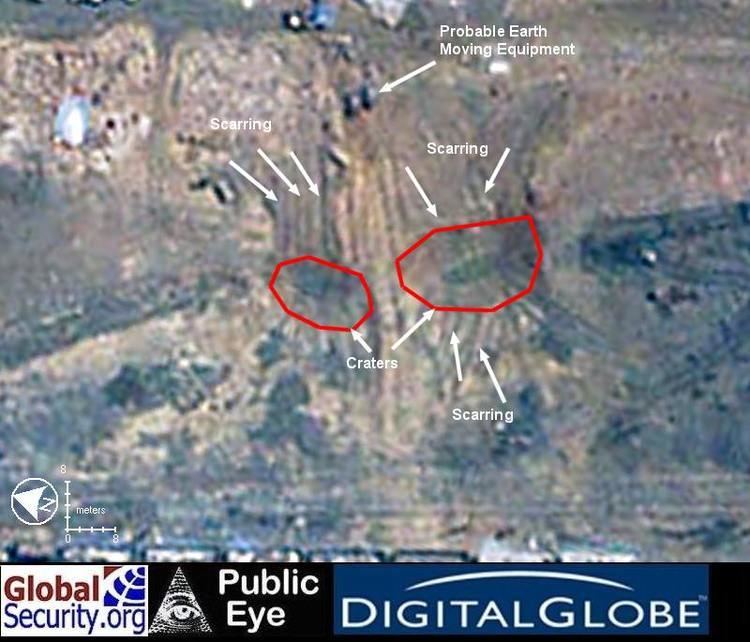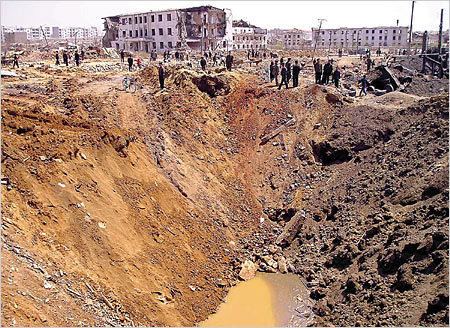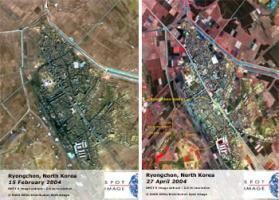Date 22 April 2004 | ||
 | ||
Location Ryongchon County, North Korea Similar Oppau explosion, Ufa train wreck, Tebay rail accident, Korean Air Flight 858, Cairns Tilt Train derailment | ||
The Ryongchŏn disaster was a train disaster that occurred on April 22, 2004, in the town of Ryongchŏn, North Korea, near the border with the People's Republic of China.
Contents

The disaster occurred when flammable cargo exploded at Ryongchon Station at around 13:00 local time (04:00 GMT). The news was released by South Korean media outlets, which reported that up to 3,000 people had been killed or injured in the blast and subsequent fires. The North Korean government declared a state of emergency in the region, but little information about the accident has been made public by the North Korean government. Shortly after the accident the North Korean government cut telephone lines to the rest of the world (an action correspondents attributed either to a desire to inhibit foreign reporting or to prevent their own population from learning news about the accident).

Effects

The Red Cross was allowed into the area, in an unusual concession from the North Korean authorities, becoming the only outside agency to see the disaster area. According to the initial agency report, 160 people were killed and 1,300 were injured in the disaster. However, official casualty reports the following day listed 54 deaths and 1,249 injuries. A wide area was reported to have been affected, with some airborne debris reportedly falling across the border in China. (Satellite pictures published by the BBC purported to show widespread damage in the town, but these were later retracted—they actually show Baghdad from an earlier date, and the strong black-white contrast was misinterpreted.) The Red Cross reported that 1,850 houses and buildings had been destroyed and another 6,350 had been damaged.

On April 23, the United Nations received an appeal for international aid from North Korea's government. On April 24, a few diplomats and aid workers were allowed into the country to assess the disaster.
Cause
The cause and nature of the accident have been the subject of considerable speculation, with several different accounts being reported.
KCNA, the state news service, apparently confirmed the Xinhua report by stating the incident was "due to the electrical contact caused by carelessness during the shunting of wagons loaded with ammonium-nitrate fertilizer".
North Korean leader Kim Jong-il passed through the station several hours before the explosion as he returned from a meeting in China. It was suggested that the explosion might have been an assassination attempt, but South Korean intelligence services believed that it was an accident. One theory is that one of the trains involved was carrying fuel from China. If the incident did involve a train collision, it has been suggested that the cause of the accident may have been a miscommunication related to the changes in train timetables due to Kim Jong-il's itinerary.
Other observers have suggested that the poor state of North Korea's railway system may have contributed to the disaster. It accounts for about 90% of freight transportation; a lack of fuel forces most vehicles off roads. The railway, built by the Japanese during their occupation of the country, is reported to be in poor repair, with elderly rolling stock running no faster than 65 kilometres per hour (40 mph) (in part due to the poor state of North Korea's electrical supply).
A curiosity about the incident is related to Operation Orchard. Shortly after the incident, a Syrian airliner landed in North Korea, purportedly to deliver aid. However, they retrieved the bodies of Syrian citizens that had been in the explosion.
North Korean government response
According to North Korean defector Thae Yong-ho, Kim Jong-il ordered the execution of several transportation officials after the disaster.
The unusually frank admission of the accident by North Korean government might have been a sign of a thaw in the grip of the party-controlled media in the country which is notorious for being a mouthpiece and being secretive. When the country suffered droughts in the early 1990s, bureaucratic inertia and reluctance to admit failure led to delays in requests for foreign aid and the deaths of millions from the famine.
